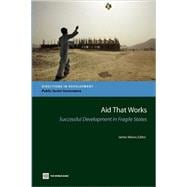
Note: Supplemental materials are not guaranteed with Rental or Used book purchases.
Purchase Benefits
What is included with this book?
| Preface | xi | ||||
| Contributors | xv | ||||
| Abbreviations | xvii | ||||
| Chapter 1 Introduction: Synthesizing Case Study Findings | 1 | (36) | |||
|
3 | (3) | |||
|
6 | (1) | |||
|
7 | (1) | |||
|
8 | (1) | |||
|
9 | (1) | |||
|
10 | (1) | |||
|
11 | (2) | |||
|
13 | (2) | |||
|
15 | (1) | |||
|
16 | (1) | |||
|
17 | (1) | |||
|
18 | (1) | |||
|
19 | (3) | |||
|
22 | (1) | |||
|
22 | (2) | |||
|
24 | (1) | |||
|
25 | (7) | |||
|
32 | (1) | |||
|
33 | (2) | |||
|
35 | (1) | |||
|
35 | (2) | |||
| Chapter 2 A Framework for Assessing Program and Project Aid in Low-Income Countries under Stress | 37 | (22) | |||
|
41 | (1) | |||
|
42 | (2) | |||
|
44 | (2) | |||
|
46 | (2) | |||
|
48 | (1) | |||
|
49 | (4) | |||
|
53 | (1) | |||
|
54 | (1) | |||
|
55 | (1) | |||
|
56 | (3) | |||
| Chapter 3 The Transition Support Program in Timor-Leste | 59 | (26) | |||
|
60 | (4) | |||
|
64 | (9) | |||
|
73 | (8) | |||
|
81 | (1) | |||
|
82 | (1) | |||
|
82 | (3) | |||
| Chapter 4 The Seila Program in Cambodia | 85 | (38) | |||
|
87 | (9) | |||
|
96 | (20) | |||
|
116 | (1) | |||
|
117 | (1) | |||
|
118 | (1) | |||
|
119 | (4) | |||
| Chapter 5 The First and Second Health Sector Rehabilitation and Development Projects in Timor-Leste | 123 | (22) | |||
|
124 | (3) | |||
|
127 | (4) | |||
|
131 | (5) | |||
|
136 | (5) | |||
|
141 | (1) | |||
|
142 | (1) | |||
|
142 | (3) | |||
| Chapter 6 The Direct Support to Schools Program in Mozambique | 145 | (28) | |||
|
146 | (2) | |||
|
148 | (2) | |||
|
150 | (9) | |||
|
159 | (1) | |||
|
160 | (4) | |||
|
164 | (2) | |||
|
166 | (1) | |||
|
167 | (1) | |||
|
168 | (5) | |||
| Chapter 7 Decentralized District Planning and Finance in One Mozambican Province | 173 | (26) | |||
|
175 | (1) | |||
|
176 | (1) | |||
|
177 | (1) | |||
|
178 | (1) | |||
|
179 | (1) | |||
|
180 | (11) | |||
|
191 | (1) | |||
|
192 | (1) | |||
|
193 | (6) | |||
| Chapter 8 The Community Fora Process in Mazar-e-Sharif, Afghanistan | 199 | (30) | |||
|
200 | (3) | |||
|
203 | (9) | |||
|
212 | (4) | |||
|
216 | (1) | |||
|
217 | (6) | |||
|
223 | (2) | |||
|
225 | (1) | |||
|
226 | (1) | |||
|
226 | (3) | |||
| Chapter 9 Aid Effectiveness and Microfinance: Lessons from Afghanistan | 229 | (24) | |||
|
230 | (4) | |||
|
234 | (1) | |||
|
235 | (5) | |||
|
240 | (8) | |||
|
248 | (2) | |||
|
250 | (1) | |||
|
250 | (3) | |||
| Chapter 10 Community-Driven Development in Conflict and Postconflict Conditions: The Northern Uganda Social Action Fund Project | 253 | (36) | |||
|
256 | (5) | |||
|
261 | (19) | |||
|
280 | (3) | |||
|
283 | (3) | |||
|
286 | (3) | |||
| Index | 289 |
The New copy of this book will include any supplemental materials advertised. Please check the title of the book to determine if it should include any access cards, study guides, lab manuals, CDs, etc.
The Used, Rental and eBook copies of this book are not guaranteed to include any supplemental materials. Typically, only the book itself is included. This is true even if the title states it includes any access cards, study guides, lab manuals, CDs, etc.